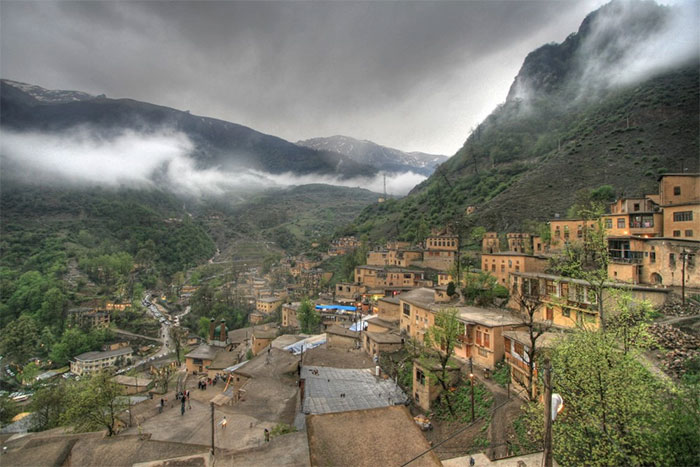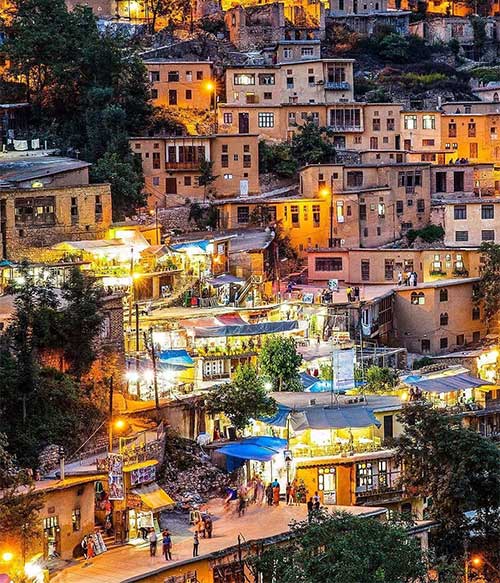Unique Village: Roofs Become Roads for Residents!
The Iranian village of Masuleh is carved into the mountainside, where rooftops serve as streets .

Masouleh village was founded around 1006 AD, once located on the 'Silk Road' of Gilan. Due to the rich iron, zinc and quartz deposits in the surrounding area, it was a thriving trading centre thanks to the iron industry. For centuries, people from all over came to this area to trade.
Located along the Silk Road, in Iran's Gilan province, Masuleh village is one of Iran's most picturesque places with lush greenery and houses towering over the mist, stacked one on top of the other.
Designed to suit the local climate, the houses in the steep mountainside village are painted bright yellow to ensure they are visible through the mist.

Masouleh has a unique architectural style, demonstrating the special adaptation of ancient Iranians to the natural conditions here. Due to the harsh climate, the summer is too hot while the winter is too cold, the ancient native Iranians often relied on the mountain slopes to build villages, taking advantage of the cliffs as a place to block the sun and wind. To adapt to the steep terrain, the people of Masouleh built houses in a terraced style with the roof of the lower house being the yard and the path of the upper row of houses. The houses in the village are usually 2 stories, built from clay and wood and close together on the steep mountainside. The unique construction structure, the yard of this house is the roof of another apartment, contributing to the attraction for tourists to visit this land.
The architecture of Masuleh is unique , as the buildings here are built into the mountain and connected to each other. What is even more special, however, is the village's ingenious use of public space: there are no clear boundaries and all the rooftops are used as courtyards, gardens and public walkways for the residents on the upper floors . The rooftops and terraces are linked together by winding steep staircases, narrow alleys and walkways, making it a multi-level, interconnected public space shared by the whole community.
Although the stairs are equipped with ramps, their sole function is to accommodate the wheelbarrows that locals use to transport goods. Because of the narrow streets and simple stairs, heavy vehicles are not allowed to move around here, Masuleh is actually the only settlement in Iran that is car-free.

Masuleh is actually the only settlement in Iran where cars are banned.
The spectacular architecture of Masuleh is called "the courtyard of the building above is the roof of the building below" . The buildings are mainly two-storey (first floor and ground floor) made of burnt bricks, clay and tree trunks. On the first floor, you will usually find a small living room, bedroom, toilet and balcony. On the lower floor will be the kitchen space connected to the upper floor by a number of narrow stairs inside the building.
Visited by an increasing number of tourists every year, Masuleh village has a history of thousands of years and is being filed to become a UNESCO World Heritage Site.

The unique multi-level, hierarchical architecture has created the uniqueness of the village . The flat roofs not only become yards and gardens but are also used as public streets, serving the travel needs of the people. This architectural style not only helps save space, but also prevents landslides, as well as creates the sustainability that has been proven over the centuries of the houses here, although the materials used to make them are only clay, stone and wood. Masouleh is especially popular with tourists because it is located in the middle of a majestic natural area, with lush green trees, very cool and pleasant in the summer, and not too cold in the winter. Each house here has a large door frame with colorful windows and is planted with very pretty flowers.
In Chaharmahal and Bakhtiari Provinces of Iran, there is a mountain complex called Sar Aqa Seyyed that has very similar architecture. Named after the local Aqa Seyyed Temple, it is known for its unusual architecture, with interconnected buildings built into the surrounding mountain. Here too, the roofs of the buildings act as courtyards and the streets of the buildings above. However, in Sar Aqa Seyyed, most of the houses have no windows and only one door.
Because of the architectural similarities, the village is also known as "Masuleh of the Zagros".


Masouleh is especially popular with tourists because it is located in the middle of a majestic natural area.
Apparently, one of the reasons why this town is little known is its geographical location. Sar Aqa Seyyed is located at an altitude of about 2,200 meters above sea level. In fact, the town has no road connections to the surrounding towns, and due to the heavy rainfall and snowfall in the fall and winter, it seems to be completely cut off from the outside world. Therefore, the village can only be visited in the spring and summer, depending on seasonal weather conditions.
- Australia encourages tree planting on the roofs
- The picturesque village has only one road.
- The roof is made of waste in India
- The unique villages in the world
- The houses with straw roofs in the capital of eight Nam Dinh rice
- Roofs absorb pollutants
- 20 beautiful green roofs like in fairy tales in Scandinavia
- The most effective way to fight against roofs
- The most original ancient village of Phu Tang
- Weird village 90% of residents have the same last name, it is not allowed to marry outsiders
- Cooler air due to bright roofs
- Unique underground village in China
 'Fine laughs' - Scary and painful torture in ancient times
'Fine laughs' - Scary and painful torture in ancient times The sequence of numbers 142857 of the Egyptian pyramids is known as the strangest number in the world - Why?
The sequence of numbers 142857 of the Egyptian pyramids is known as the strangest number in the world - Why? History of the iron
History of the iron What is alum?
What is alum?